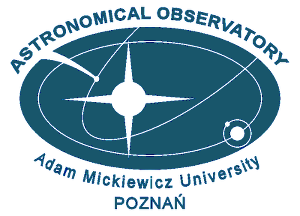Projects
European Space Agency programs
In 2009 the European Space Agency launched the Space Situational Awareness (SSA) Programme. Its goal is to protect space infrastructure (artificial satellites) as well as ground-based installations from hazards due to inactive satellites and fragmmentation debris (SST), space weather (solar radiation and particles, SWE), and Near Earth Objects (NEO). Our Observatory, collaborating closely with the IT industry, is active in the SST and NEO segments. We work on several contracts to ESA which shall enhance the web based services offered at the NEO portal.
BRITE Consortium
Spectroscopic telescopes PST1 and PST2 (together working in GATS network) participate in research programs of the international BRITE consortium (Bright Targer Explorer). BRITE satellites were designed for photometry of the bright stars in selected wavelength bands. Polish satellites as a part of BRITE system (Lem and Heweliusz) provide unique, continuous photometric data, which needs to be supplemented with high resolution spectroscopy. GATS telescopes participate actively in the GBOT (Ground Based Observing Team) network, created as a ground-based support for BRITE observations. Ground-based observations performed simultaneously with observations from satellites are used for the radial velocity measurements and analysis of chemical and physical properties of studied objects.
ILMT
Astronomical Observatory in Poznan is a member of the international consortium ILMT (International Liquid Mirror Telescope), led by Institute of Astrophysics, Geophysics and Oceanography of the Liege University (Belgium). One of main aims of this consortium is to build a 4 m liquid (mercury) mirror telescope. We actively participate in this project since 2006. Further research will be based on observations performed with this new telescope. Our present contribution include construction of a computer cluster placed in our observatory and writing software needed for reduction of the observational data. Activity of our Observatory will be focused mostly on studying asteroids and space debris.
VLT/SPHERE large programme
Our institute is actively involved in a large observational programme with the Very Large Telescope (VLT), European Southern Observatory (ESO), Chile. The VLT consists of four individual telescopes, each with a primary mirror 8.2 m across, which can be used together to achieve very high angular resolution.
Using the SPHERE instrument attached to the VLT, we are carrying out a survey of a substantial fraction of all D>100 km main-belt asteroids, sampling the four main compositional classes: S, Ch/Cgh, B/C, P/D. Observations are gathered throughout their rotation in order to derive their volume (via their 3-D shape) which combined with already existing mass estimates will allow us to determine their bulk density.
GAVIP-GridComputing
We have started negotiations with ESA to begin the works on a new project called GAVIP-GridComputing. GAVIP-GC is a distributed computing platform that will provide processing power for scientific analysis of data gathered by ESA Gaia mission. Access to Gaia data will be provided by GAVIP, which is an already deployed tool (http://docs.gavip.science/) that allow scientists to submit and share algorithms for extracting and analyzing Gaia data.
In turn, GAVIP-GC will enhance the potential of GAVIP as will solve one of the main constraints of the platform, namely the lack of processing power provision for highly CPU demanding processes. Volunteer network will be created as a BOINC project (https://boinc.berkeley.edu/), which provides a robust structure for collaborative networks.
The duration of the project is 24 months, and our observatory will develop all the required software as a prime contractor. The budget of the project is 200 kEUR.
GAVIP-GC is the sixth ESA project realized by our Observatory in the framework of
Space Situational Awareness programme.

